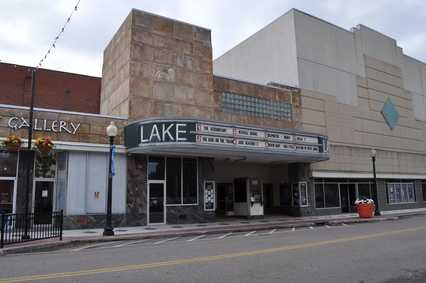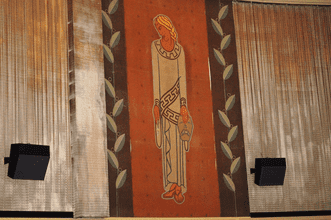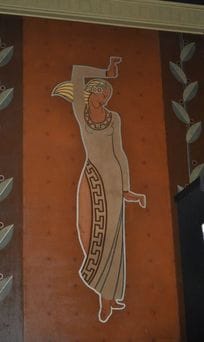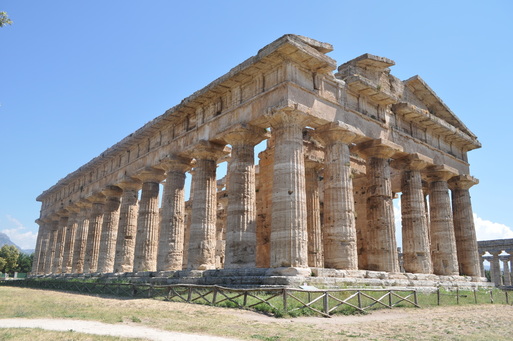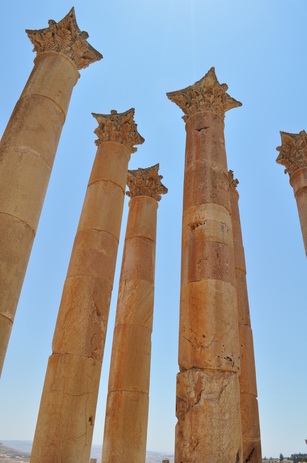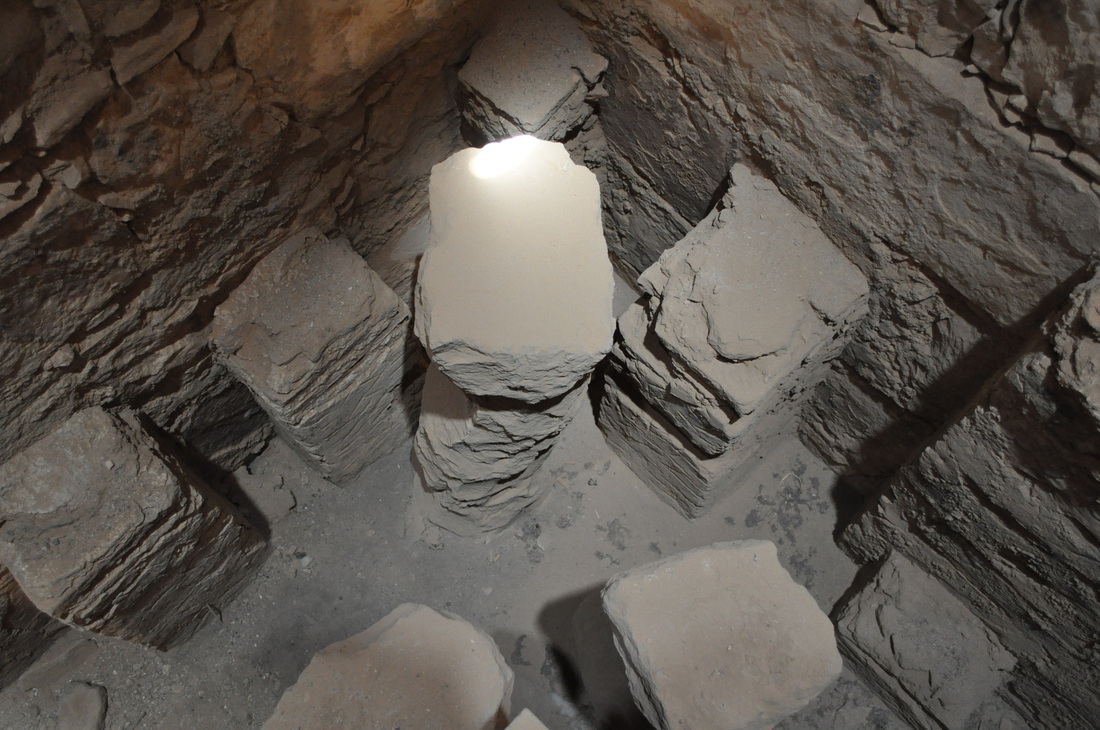|
Sing O Muse of movie houses of the past, of glittering marquees and of unwavering dedication to the arts. Tell us Muse, of a small Ohio town during the Great Depression and its commitment to cultural treasures. There is a place called The Lake 8 Movies Theatre where the Muses did grant special inspiration. “The Lake,” opened in 1938, a privately funded project by two Barberton businessmen, Frank Gaethke and Harold Makinson. The Lake was designed in Art Moderne, a late style of Art Deco architecture. The theater retains the main features of this style today. Local Barberton artist, Wilson Roy Heller, was hired to paint a set of murals. These stunning murals continue to draw interest and help to define downtown Barberton. Known for political, Modernist art, the Muses of The Lake were an exquisite departure from his standard art. Of the eight total murals there are depictions of six muses from ancient Greek Mythology, the god Apollo, and a Poet. In the lobby opposite the snack bar visitors are greeted by Calliope holding a lyre. Foremost among Muses she inspired epic poetry, music, song and dance. Her name means “beautiful-voiced” in Ancient Greek. Calliope shares a wall with Clio, the muse of history. Her name can be translated as “famous” or “glory.” In ancient iconography Clio often carried an open scroll or tablet. Heller paints her with a book bound in a way modern audiences could recognize. Other Muses are represented as well. The goddess of tragedy, Melpomene, gazes downward while holding a mask of tragedy in her left hand. Facing her on the same wall is male figure with an open scroll. Perhaps he is a personification of poetry, or an illustration of famous poets like Ovid or Vergil. Another male figure, Apollo, looks directly at Thalia, the muse of comedy. She returns his glance while holding a comedic mask in both hands. The bare-chested Apollo bears a bow and quiver filled with arrows. Apollo was a complex deity who served a variety of religious roles in the ancient world. He is often known as the leader of the Muses. In Ancient Greece Terpsichore was frequently depicted sitting down and holding a lyre. At The Lakes however Heller allows the goddess of dance the freedom of movement. Her right hand is raised above her head and her right leg moves to imaginary music. She is identified by her perceived actions rather than an instrument. The flowers above her right ear lend a gaiety to her personality. Terpsichore shares a wall with Urania, the muse of the heavens. Urania holds a celestial orb with both hands. The orb appears to note the cardinal directions. Urania’s robe, as with the other Muses, features a streamlined Greek key pattern. Chances are, if you are from Summit County, Ohio you already know about The Lake 8’s Muses. However, if you are not from the area, Barberton is worth the drive. It is only 45 minutes southeast of Cleveland. Visit http://lake8movies.com/web to learn movie times and hours of operation. Barberton is also experiencing a renaissance, visit http://www.annadeanfarm.com to learn more about the other historic buildings in this fascinating city. Near the theater, art gallery and coffee house Nine Muses Art Gallery is the perfect place to sip a warm drink while discussing a movie plot or to work on your novel. Perhaps the Muses will visit you too, all you have to do is call on them.
37 Comments
In an age when cinder blocks and drywall are considered quality construction materials the architecture of the past might seem all but forgotten. Have you ever wondered why looking at ancient Greek temples is pleasing, calming, and/or inspiring? It’s all about the elements of the three main architectural orders: Doric, Ionic, and Corinthian. Two buildings, far apart historically and geographically, demonstrate the essentials of the Doric Order. Capital The most defining characteristic of the Doric Order is the column capital. The highest portion is more or less plain. Curly elements and carved flowers belong to other orders. A quadrangular-shaped piece tops the column and serves as the topmost section of the capital. The curved pillow-like segment between the very top and the column itself is called the echinus. Everyone loves a good echinus; it’s the place where column capital becomes the column itself. Echnini can be slim or puffy and they can define a structure. The Indianapolis Public Library boasts (mostly) Doric elements. Here, a square-shaped capital tops a sleek echinus and introduces a slender column. This modern building is 100 years old and was inspired by the temples of Greece’s past. The library is located on direct axis to another Classics-inspired Indianapolis landmark – the War Memorial. Entasis
The columns are no doubt the single most defining quality of Greek architecture. When the slight outward curvature of the columns at the Indianapolis Public Library are compared with those of the Temple of Hera (II) in Pestum, Italy a column’s entasis is apparent. Entasis is the bulging of the column drums (horizontal “blocks”) – smaller near the top and largest in the middle. Entasis was used to correct the flat, convex look straight columns have from a distance. The height of an entire temple was usually four to six times the diameter of the shaft at its lowest point. Fluting Those vertical grooves on columns are called flutes. Some think flutes may have developed as a permanent representation of the grooves in the timber of pre-marble structures. However, the combination of shadow and light created by the flutes reinforces its round structure when viewed from afar. The last column drum sits directly on the stylobate (base) of the building. The flutes lead directly to the base without a round horizontal element placed in between. Modern buildings, like the Indianapolis Public Library, will bend that rule. The designers placed a round base between the base of the column and the stylobate. The Temple of Hera (II)’s columns sit directly on the stylobate, as is normal for the Doric Order. So, whether it’s a child’s school assignment or an idea to redecorate your home – the right mix of entasis, echinus, and fluting can enhance your project. At the very least, knowing the basics of the Doric Order will enhance your understanding of new and old buildings alike. The monumental architecture of the Ancient Greeks and Romans continues to influence and inspire modern culture. If you have never studied the Classics it can be hard to tell the difference. However, there are subtle (and not-so-subtle) differences. Knowing them can enhance your understanding of the ancient world, or at least give you something to talk about at your next dinner party. All About The Angles Greek temples are often constructed up on a mountain or on high ground. The approach to the temple is itself an experience - a winding path can keep the temple out of view. It is only emerging from a front gate or a path that a tourist experiences the structure in its majesty – seeing the long and the short sides simultaneously. Greek temples are often rectangular in form, the entrance isn’t necessarily clear and they are best approached at an angle. The ingress to a Roman temple is quite obvious. Roman priests ascended a distinct staircase into a temple which was built upon a pedestal. The Temple of Isis in Pompeii, Italy is dedicated to an Egyptian goddess but its Roman construction is apparent. The Temple is set on a platform with a precise main entrance and is a little boring to look at from certain angles. Roman temples are best appreciated from the front. The Columns On The Temple Go Around and Around Generally, the columns of a Greek temple are peripteral – constructed around the temple on all sides. The Temple of Hera (II) at Pestum, Italy is located in a former Greek colony called Poseidonia. Although built using local tufa (not marble) this structure is easily identified as Greek due to its use and placement of columns. If columns are the first feature you notice when looking at a structure – Greek is your safe bet. Roman temples often feature columns in the front. The large Corinthian (fanciest type) columns of the Temple of Artemis in Jerash, Jordan are so large they make the visitor lose their natural sense of scale. Jerash was a Hellenistic (Greek) town, which later became Roman territory in 63 BC so it is a good location to compare the two building styles. Sometimes the sheer size of Roman columns is enough to characterize a structure was built with a Roman eye. Remember the Romans conquered vast stretches of land so you will see Roman-built structures outside of Italy. Some Roman emperors (like Hadrian) admired the Hellenistic world so much they copied Greek architecture, making this topic a little more complicated than I have treated it here. From the use and placement of columns to the scale and entrance of these buildings the architects of the ancient world left us with a wide array of structures to enjoy. Disclaimer: This post is intended to aid non-classicsts and non-architects identify ancient buildings. This is by no means a replacement for actual education.
|
AuthorRosina Eileen Khan is an Archives
January 2017
Categories |
